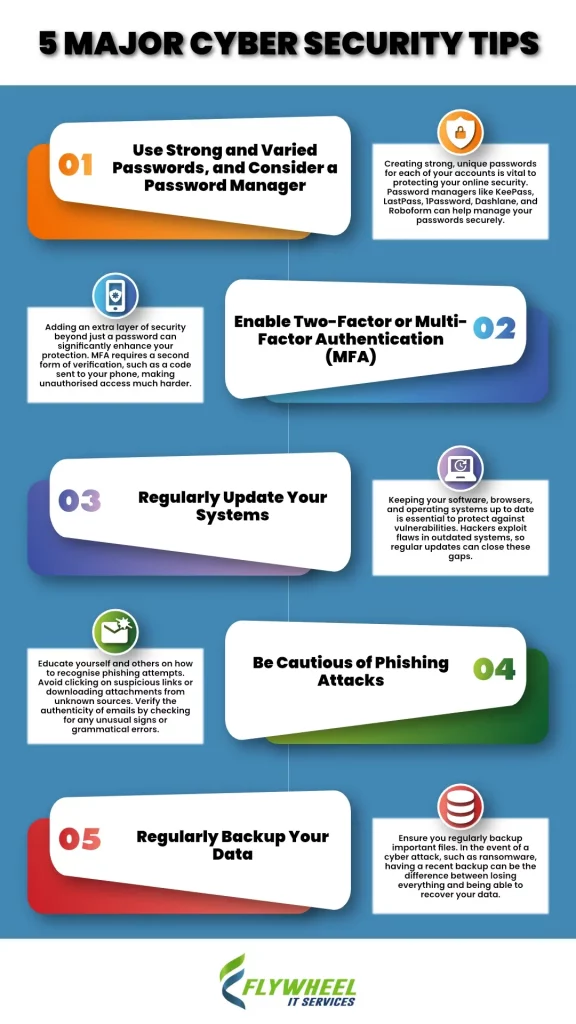Introduction: The Importance of Cybersecurity for Modern Businesses
In today’s interconnected and digitised world, businesses of all sizes are increasingly becoming targets for cyber threats. These threats can result in data breaches, financial losses, reputational damage, and operational disruptions. Cybersecurity is no longer a luxury for modern businesses; it has become a necessity.
The importance of cybersecurity has never been more evident than in the aftermath of high-profile data breaches affecting organisations in various industries. These incidents have exposed businesses’ vulnerability to various forms of cyber threats and underscored the need for robust cybersecurity measures.
A Brief Overview of the Evolution of Cybersecurity Threats
Cybersecurity threats have evolved significantly in recent years, with cybercriminals employing increasingly sophisticated tactics to breach organisational defences. Some of the most concerning trends include:
- Ransomware Attacks: These attacks involve the encryption of an organisation’s data with a demand for payment in exchange for the decryption keys. Ransomware attacks can be devastating for businesses, leading to losses of millions of dollars and compromising sensitive information.
- Malware as a service (MaaS): This model allows cybercriminals to rent out advanced malware tools and infrastructure to launch sophisticated attacks against businesses.
- Phishing Attacks: These attacks use social engineering techniques to trick employees into divulging sensitive information or clicking malicious links.
- Artificial Intelligence (AI) Threats: AI technology is increasingly being used by cybercriminals to create more sophisticated and targeted attacks, such as AI-driven phishing schemes and generative adversarial networks (GANs).
- Third-party Cyber Threats: These threats arise from an organisation’s relationships with third-party vendors and suppliers, who may unknowingly introduce vulnerabilities into the organisation’s systems.
The Purpose and Structure of the Article
This article aims to provide a comprehensive overview of the top cybersecurity threats businesses will face in 2024. Each chapter will focus on a specific threat, delving into its evolution, potential impact on businesses, and recommended mitigation strategies. Throughout the article, we will also highlight the importance of proactive measures in addressing these threats, with an emphasis on investing in advanced security solutions, implementing strong security protocols, and educating employees on cybersecurity best practices.
The following chapters will explore the top five cybersecurity threats predicted for 2024 and provide an in-depth analysis of each threat, along with practical recommendations for businesses seeking to protect themselves. These threats include:
- Ransomware attacks.
- Malware as a service (MaaS).
- Evolving phishing attacks.
- Quantum computing threats.
- Artificial Intelligence (AI) threats.
By the end of this article, readers will have a thorough understanding of the significant cyber threats that businesses face in 2024 and the steps they can take to mitigate these risks.
Claim: the Top 5 Cybersecurity Threats Faced by Businesses in 2024
Evidence: Increasing Reported Incidents of Cyberattacks and Their Financial Impact
The latest data breach report reveals that cyberattacks continue to grow in frequency and scale. Businesses worldwide were affected by 3,950 confirmed data breaches, resulting in more than 294 million exposed records. This trend is expected to persist in 2024 and beyond as cybercriminals continually refine their tactics to exploit businesses’ vulnerabilities.
This growing wave of cyberattacks is increasing in volume and financial impact. The global cost of cybercrime is predicted to reach $9.5 trillion USD annually by 2025, with businesses shouldering a large portion of these losses. This financial toll emphasises the need for modern enterprises to recognise and prioritise cybersecurity as a vital component of their operations.
Warrant: Cybercriminals Constantly Update Their Tactics, Making It a Growing Concern for Businesses
Cybercriminals constantly evolve their tactics to capitalise on new opportunities arising from technological advancements and emerging vulnerabilities. As a result, even businesses with robust security measures can fall victim to sophisticated cyber threats. As the cybercriminal landscape becomes increasingly complex, businesses must adapt their cybersecurity strategies continually to stay ahead of emerging threats.
In light of this evolving environment, this article highlights the top 5 cybersecurity threats that businesses are likely to encounter in 2024. By understanding these threats and developing targeted mitigation strategies, organisations can minimise their risk of financial, reputational, and operational damages.
- Ransomware attacks: Exploiting vulnerabilities in outdated systems and targeting businesses with weak security protocols.
- Malware as a service (MaaS): Growing accessibility of tools for launching advanced cyberattacks.
- Evolving phishing attacks: Difficulty in detecting and preventing advanced phishing campaigns.
- Quantum computing threats: The potential for quantum computing to break encryption algorithms and compromise sensitive data.
- Artificial intelligence (AI) threats: Increased use of generative AI and similar tools for launching sophisticated attacks.
Ground 1: Ransomware Attacks
Subclaim: Ransomware Attacks Will Remain a Significant Threat
Ransomware attacks continue to be a major concern for businesses. Cybercriminals employ increasingly sophisticated techniques to infiltrate networks and encrypt sensitive data. Recent cyber predictions indicate that these attacks will remain a prevalent threat in 2024 and beyond.
Evidence: Exploitation of Vulnerabilities in Outdated Systems and Targeting Businesses with Weak Security Protocols
Ransomware attackers often exploit vulnerabilities in outdated systems and software to deploy their malicious code. Upon gaining access to a victim’s network, the attacker encrypts valuable data, making it inaccessible to the business. In exchange for the decryption key, the attacker demands a ransom payment, typically in the form of cryptocurrency.
According to the latest data breach report, ransomware attacks have become more targeted. Cybercriminals are increasingly focusing on organisations with weak security protocols or valuable data. Furthermore, recent third-party cyber threats highlight the risks associated with supply chain vulnerabilities.
Last year, at least 8,214,886,660 records were breached as a result of data breaches and cyber attacks, leading to a staggering financial impact for affected businesses. These figures demonstrate the continued proliferation of ransomware attacks and underscore the importance of robust cybersecurity measures.
Warrant: Businesses Must Regularly Update Their Systems and Strengthen Security Measures
To effectively mitigate the risk of ransomware attacks, businesses must take proactive measures to enhance their cybersecurity defences. Regularly updating systems and software and implementing strong security protocols can help reduce vulnerabilities that cybercriminals may exploit.
Implementing a zero-trust architecture, which assumes that all network traffic is potentially hostile, can help fortify a business’s external attack surface. By verifying and authenticating every user, device, and connection, businesses can significantly reduce the likelihood of succumbing to a ransomware attack.
Furthermore, a thorough threat-hunting report can help identify potential weaknesses and eliminate advanced persistent threats before they can cause significant harm. By establishing a comprehensive cybersecurity strategy encompassing regular system updates, rigorous protocols, and robust threat hunting, businesses can minimise their exposure to ransomware attacks.
Ground 2: Malware as a Service (MaaS)
Subclaim: The Availability of MaaS Will Increase, Enabling More Sophisticated Attacks
Malware as a Service (MaaS) is a growing concern for businesses. It provides cybercriminals with an easy-to-use platform for launching sophisticated attacks. By reducing the technical expertise required to create and deploy malware, MaaS is expected to become increasingly prevalent in the cybersecurity landscape in 2024 and beyond.
Evidence: Growing Accessibility of Tools for Launching Advanced Cyberattacks
According to recent cyber predictions, MaaS will continue to increase as the accessibility of tools for launching advanced cyberattacks increases. These platforms often operate on a subscription model, allowing cybercriminals to rent malware and other tools for short periods, further reducing the barriers to entry for would-be attackers. Additionally, the dark web serves as a thriving marketplace for MaaS offerings, facilitating the rapid exchange of malicious software.
As a result, the security industry is witnessing a rise in identity-based attacks and business email compromise (BEC) incidents, with reported losses due to BEC scams costing companies $50 billion.
Warrant: Businesses Must Adapt Their Defences to Detect and Mitigate MaaS- MaaS-enabled attacks
Given the growing availability of MaaS solutions, businesses must enhance their defences to counter these evolving cybersecurity threats effectively.
- Strengthen Cloud-native Security: Organisations must prioritise securing their cloud environments, as MaaS attacks frequently target cloud infrastructure. By adopting multi-layered security measures and ensuring proper cloud service configuration, businesses can reduce their vulnerability to MaaS-enabled threats.
- Implement Zero-trust Architecture: To minimise the risk of identity-based attacks, businesses should implement a zero-trust security model that requires continuous authentication and verification of users and devices. By removing implicit trust, zero-trust architecture can help prevent the spread of malware and other cyber threats within an organisation.
- Invest in Threat-hunting Programs: To proactively identify and mitigate MaaS-enabled threats, businesses should invest in threat-hunting programs that actively search for signs of compromise and employ advanced analytics to detect malicious behaviour. By regularly conducting threat-hunting activities, organisations can stay ahead of emerging threats and minimise the impact of potential attacks.
Ground 3 – Evolving Phishing Attacks
Subclaim: Phishing Attacks Will Continue to Evolve and Become More Sophisticated
As cybersecurity evolves, so do the tactics employed by cybercriminals. Phishing attacks, one of the oldest and most prevalent forms of cyber-attacks, are becoming increasingly sophisticated and targeted. Criminals now exploit AI-driven phishing schemes, making it difficult for traditional security measures to detect and prevent such attacks.
Evidence: Difficulty in Detecting and Preventing Advanced Phishing Campaigns
In a recent report, an estimated 3.4 billion spam emails are sent every day. A significant portion of these incidents was attributed to advanced phishing methods like business email compromise (BEC) and man-in-the-middle (MitM) attacks.
AI-driven Phishing Schemes
Attackers are exploiting generative AI models and Generative Adversarial Networks (GANs) to create convincing phishing emails and websites that bypass traditional security filters.
Supply Chain Threats
Phishing campaigns are increasingly targeting vendors and third-party suppliers. They exploit the trust between businesses and their partners to gain unauthorised access to sensitive data.
Identity-based Attacks
Cybercriminals are also using stolen credentials to launch identity-based attacks, making it difficult for organisations to distinguish between legitimate users and hackers.
Warrant: Businesses Must Implement Robust Email Security Measures and Educate Their Employees
To safeguard against the evolving landscape of phishing attacks, businesses must adopt a multilayered cybersecurity approach that includes:
Advanced Email Security Solutions
Organisations should deploy AI-powered email security tools that can detect and block sophisticated phishing attempts, analyse external attack surfaces, and monitor for potential cyber threats.
Employee Education and Awareness
Regular training programs should be conducted to educate employees on identifying and mitigating phishing attacks. By instilling a culture of security consciousness, businesses can reduce the risk of successful phishing attempts.
Zero Trust Architecture (ZTA)
Implementing a Zero Trust Architecture can help minimise the potential damage caused by phishing attacks by requiring strict verification for every user, device, and network connection (7).
Incident Response Planning
Establishing a clear incident response plan enables businesses to respond quickly and effectively to phishing attacks, minimising potential damage and protecting sensitive information.
Ground 4 – Quantum Computing Threats
Subclaim: Quantum Computing Poses Significant Threats to Businesses
Quantum computing is poised to change the cybersecurity landscape. It has the potential to render current encryption algorithms ineffective, putting businesses at significant risk of data breaches, as sensitive information may become vulnerable to unauthorised access.
Evidence: Vulnerabilities of Current Encryption Standards
In a quantum computing age, cybercriminals’ return on investment (ROI) is expected to escalate as advanced cryptography techniques can easily decrypt previously secure data. High-profile data breach reports already indicate instances where quantum computing capabilities were used to compromise corporate networks.
Quantum Computers’ Processing Power
Quantum computers can solve complex algorithms exponentially faster than classical computers, posing a threat to modern encryption standards that primarily rely on complex mathematical problems.
Shor’s Algorithm
The development of Shor’s algorithm, which can efficiently factorise large numbers, threatens RSA encryption and similar systems.
Warrant: Businesses Must Stay Informed of Quantum Computing Developments and Prepare for New Encryption Standards
To ensure their information security remains robust in the era of quantum computing, businesses must prepare by:
Staying Informed on Quantum Computing Advancements
Regularly keeping up-to-date with the latest developments in quantum computing will enable organisations to make informed decisions regarding their cybersecurity defences.
Investigating Post-quantum Cryptography (PQC)
New encryption protocols, such as lattice-based cryptography and elliptic curve cryptography, can offer better resistance to quantum attacks. Adopting PQC solutions can help mitigate the risks associated with quantum computing.
Collaborating With Cybersecurity Experts
Working with cybersecurity professionals and organisations that specialise in quantum-resistant cryptography can offer unique insights and help companies stay protected.
Future-proofing Cybersecurity Strategies
Incorporating potential quantum threats into their overall cybersecurity strategies will enable businesses to remain resilient to evolving cyber risks.
Ground 5: Artificial Intelligence (AI) Threats
Subclaim: AI Threats are on the Rise as Cybercriminals Adopt New Tools
Advancements in AI and machine learning are enabling cybercriminals to develop more sophisticated attacks. These AI-powered threats are challenging traditional cybersecurity defences, necessitating a shift in businesses’ approaches to protecting their assets.
Evidence: Increased Use of Generative AI and Similar Tools for Launching Sophisticated Attacks
Deepfake technology, powered by generative AI, is allowing cybercriminals to create highly realistic and convincing fraudulent content. This includes fake audio, video, and text messages, which are often used in targeted spear-phishing campaigns to deceive victims.
Additionally, AI tools are being employed to automate and improve the efficiency of malware attacks. For instance, AI can help identify vulnerabilities and customise malware strains to evade detection by traditional antivirus software.
Warrant: Businesses Must Adapt Their Security Strategies to Address AI-driven Threats
To effectively combat AI-powered threats, businesses must adapt their security strategies to be more proactive and dynamic. This includes:
- Implementing AI-based Cybersecurity Solutions: Investing in AI and machine learning-based tools that can detect and mitigate AI-driven threats in real time.
- Fostering Collaboration Between AI Researchers and Cybersecurity Professionals: Encouraging cross-disciplinary collaboration to develop a deeper understanding of AI threats and develop effective countermeasures.
- Regularly Updating and Improving Cybersecurity Infrastructure: Staying up-to-date with the latest advancements in AI-driven cybersecurity tools and strategies to maintain a robust defence against emerging threats.
Mitigation Strategies to Address Cybersecurity Threats
Investing in Advanced Security Solutions
To counteract the rising sophistication of modern cybersecurity threats, businesses must prioritise investments in advanced security solutions. This includes:
- Utilising Artificial Intelligence and Machine Learning for Threat Detection: AI and ML algorithms can detect anomalies that might indicate threats, enabling security teams to address potential issues before damage occurs proactively.
- Adopting Cloud-Native Security Measures: As more organisations migrate to cloud platforms, securing these environments should be a top priority. Cloud-native security tools can help uncover vulnerabilities and detect threats in real time.
- Implementing Zero Trust Architecture: Zero trust architecture enforces stringent access controls and continuously verifies user identities, effectively reducing the risk of identity-based attacks and minimising the potential damage from breaches.
Implementing Strong Security Protocols
Establishing comprehensive security protocols is crucial for safeguarding an organisation’s sensitive data and digital assets. These protocols should include:
- Regular System Updates and Patch Management: Ensuring that all systems are running on the latest software and firmware will decrease the likelihood of exploitable vulnerabilities.
- Robust Access Controls and Password Policies: Enforcing strong password policies and employing multi-factor authentication (MFA) can help prevent unauthorised access.
- Incident Response Planning and Training: Preparing for potential cyber incidents through detailed incident response plans and regularly training employees can significantly minimise the impact of a breach.
Employee Education and Awareness
Human error is often a factor in successful cyberattacks. By educating employees on security best practices and staying informed about current threats, organisations can reduce the risk of falling victim to cybercrime.
- Security Awareness Training: Conduct training sessions and workshops regularly to ensure that employees are aware of the latest cyber threats and understand how to protect themselves and the organisation.
- Encouraging a Security-Minded Culture: Fostering an organisational culture that emphasises the importance of security can make employees more vigilant and proactive against potential vulnerabilities.
By developing a well-rounded approach to cybersecurity and employing advanced technologies and protocols, businesses can effectively mitigate the risks posed by modern digital threats and protect their vital assets and data.
Conclusion
Key Findings and Cybersecurity Threats
The most pressing threats in 2024 included ransomware attacks, malware as a service (maas), evolving phishing attacks, quantum computing threats, and artificial intelligence (AI) threats. The interconnectedness of systems and devices, as well as the increasing sophistication of attackers, necessitates a re-evaluation of traditional cybersecurity strategies.
Encouragement for Proactive and Preventive Cybersecurity Measures
To protect valuable digital assets, businesses should adopt a comprehensive, forward-thinking, and multi-layered cybersecurity approach. This strategy should encompass education, awareness, and modern technologies and also focus on collaboration and information sharing among industry peers, government agencies, and law enforcement partners. Investing in cutting-edge tools and fostering a culture of cybersecurity awareness among employees can significantly reduce the risk of successful cyber attacks. Conducting regular security audits and vulnerability assessments will help organisations identify potential weaknesses and mitigate them before they can be exploited. By integrating incident response and disaster recovery plans, organisations can develop resilience and minimise the impact of cyber incidents.
Final Thoughts and Moving Forward
As the cybersecurity landscape continues to evolve, businesses must remain vigilant and adapt their defence strategies accordingly. By staying informed and taking proactive and preventive measures, organisations can better protect themselves against emerging threats and safeguard their valuable digital assets. Cybersecurity is an ongoing journey, and the dedication to continuous learning and improvement is essential for success. By working together and pooling resources, knowledge, and expertise, organisations can better protect themselves in the ever-changing digital world.
FAQ Corner
How Can Businesses Prepare for Future Cybersecurity Threats?
To prepare for future cybersecurity threats, businesses should implement robust security measures, stay informed on emerging threats, and continually adapt their strategies. This includes investing in AI-powered security tools, fostering a culture of security awareness, and collaborating with other organisations to share threat intelligence.
Are Certain Industries More Vulnerable to Cyber Threats?
Certain industries, such as finance, healthcare, and technology, are often targeted due to the sensitive data they possess. However, all industries are susceptible to cyber threats and should prioritise security measures based on their unique risk profiles.
How Can AI Be Utilised to Strengthen Cybersecurity Defences?
AI can significantly improve cybersecurity defences by detecting patterns and anomalies, predicting and preventing attacks, and enhancing threat intelligence. AI-powered tools can quickly analyse large amounts of data, enabling organisations to respond more effectively to security incidents.
What Role Does Employee Education Play in Mitigating Cybersecurity Risks?
Employee education is critical in mitigating cybersecurity risks, as human error is a common factor in many successful attacks. By training staff on security best practices, organisations can minimise the likelihood of phishing, malware, and other social engineering attacks.
How Can Businesses Maintain Secure Remote Work Environments?
To ensure secure remote work environments, businesses should prioritise access control measures, implement robust network security protocols, provide secure communication tools, and regularly educate employees on safe remote work practices.
How Can Organisations Effectively Respond to a Data Breach?
An effective data breach response should involve quickly identifying and isolating the breach, assessing its impact, notifying affected parties, and working with relevant authorities to investigate and mitigate the breach. Organisations should have a well-documented incident response plan in place to ensure a swift and coordinated response.
Is Your Business Secure Enough for Today’s Cyber Threats?
Keeping up with evolving cyber security risks can be overwhelming. Have you considered penetration testing to uncover potential vulnerabilities and stay ahead of threats?
Flywheel IT Services can help fortify your defences. Let’s work together to protect your business from cyber attacks.




